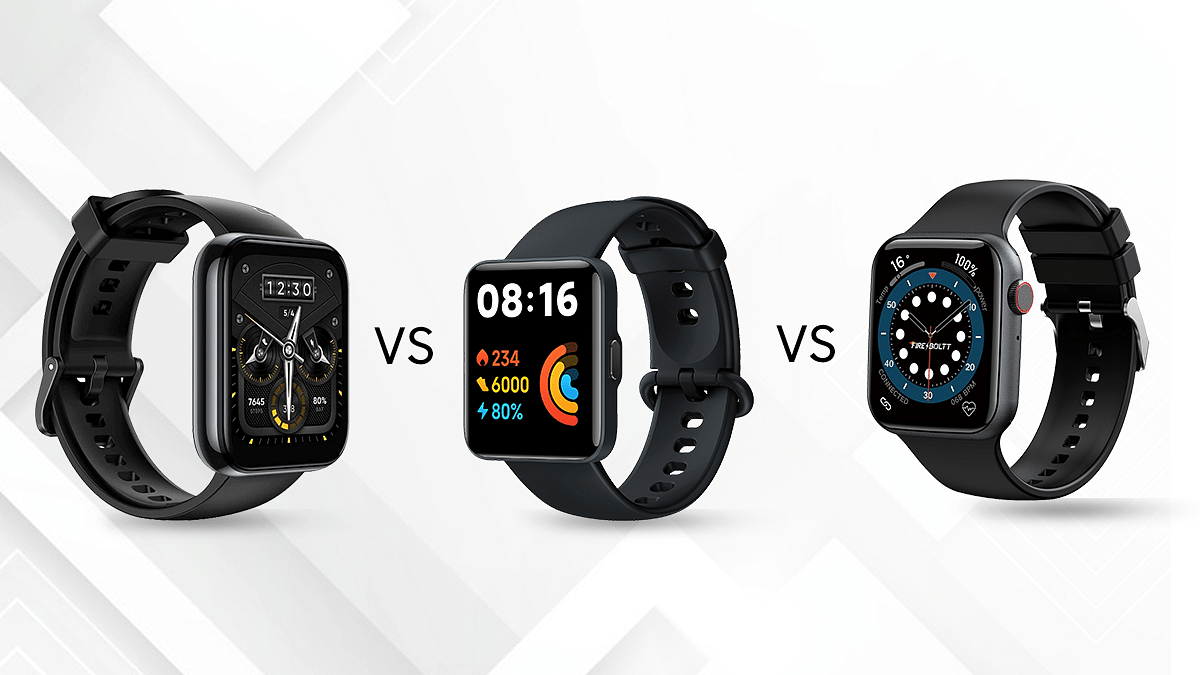The Redmi Watch 2 Lite is the latest budget smartwatch that comes for Rs. 4,999. Considering the price, it is a direct competitor to the previously launched Realme Watch 2 Pro and Fire-Boltt Ring. These smartwatches share many common features but which one is the best buy? In this article, we are going to compare these smartwatches and how Realme Watch 2 Pro, Redmi Watch 2 Lite, and Fire-Boltt Ring compete against each other. Let’s have a look:
Design And Display
The Realme Watch 2 Pro and the Redmi Watch 2 Lite are made of plastic material. But the Redmi Watch 2 Lite has a rubber build. The Fire-Boltt, on the other hand, has a sturdy metallic build finish. Its square body resembles the Apple Watch in terms of style.
The Realme Watch 2 Pro has a 1.75-inch IPS display. On the other hand, the Redmi Watch 2 Lite sports a 1.55-inch panel, and the Fire-Boltt Rings have a 1.7-inch touch screen.
The Realme Watch 2 Pro has a bigger dial with 2.5D glass on the screen and curved edges. On the other hand, the Redmi Watch 2 features a flat edge design and 2.5D glass. Coming to the Fire-Boltt Ring, it has a 2.5D curved display.
In real-life usage, the display of these watches looks good in terms of colors, brightness, and sharpness. Furthermore, the display of the Realme Watch 2 Pro is bigger, so the icons and texts are bigger for easy access.
Overall, the display of Realme Watch 2 Pro, Redmi Watch 2 Lite, and Fire-Boltt Ring is good enough to use in any condition. But we prefer the Realme Watch 2 Pro’s display because of its big screen size and smoother experience.
Features And Operating System
In terms of health and activity tracking, the Redmi Watch 2 Lite, Realme Watch 2 Pro, and the Fire-Boltt Ring pack all essential features. The Redmi Watch 2 Lite features over 100 sports modes. On the other hand, the Realme Watch 2 Pro has 90 sports modes.
Moving to the Fire-Boltt Rings, it brings a 24×7 heart-rate monitor, a SpO2 sensor for tracking blood oxygen saturation, and a motion sensor for tracking daily activities. The Redmi Watch 2 Lite and the Realme Watch 2 Pro have built-in GPS. The Fire Boltt Ring doesn’t support GPS.
The Redmi Watch 2 Lite and the Realme Watch 2 Pro track better steps, calories, and distance due to more accurate data with GPS. Besides, the Fire-Boltt Rings feature a sleep monitor, various sports modes, and an activity tracker that keeps records of calorie burn, step count, distance, etc.
Coming to the OS, the Realme Watch 2 Pro is an RTOS-based watch. This means you cannot add any additional apps. On the other hand, the Redmi Watch 2 Lite runs Xiaomi’s own software. Moving to the Fire-Boltt Ring, it runs on a proprietary OS that comes with a quick-access honeycomb menu.
Battery And Connectivity
The Redmi Watch 2 Lite boasts a 225mAh battery. On the other hand, the Realme Watch 2 Pro is powered by a 390mAh battery. Besides, the Fire-Boltt Ring delivers a total of 8-days of battery life.
As per the brand’s claims, the Redmi Watch 2 Lite and Realme Watch 2 Pro can provide up to 10 days of backup in ordinary use and two weeks on a single charge, respectively. The circular magnetic charger for the Realme Watch 2 Pro looks premium and has a better build.
On the other hand, Redmi Watch 2 Lite has a POGO pin magnetic charger. The Fire-Boltt Ring is backed by a Lithium-Ion battery that gets juice from a charger dock out of the box. Coming to the connectivity options, Xiaomi’s Redmi Watch 2 Lite has Bluetooth 5.0 and NFC.
The smartwatch is compatible with devices running on Android 6.0+ and iOS 9.0+. Moving to the Realme Watch 2 Pro, you get Bluetooth 5 and it is compatible with Android devices. On the other hand, the Fire-Boltt Rings feature Bluetooth 5 for better range and fast speed. All three smartwatches are compatible with iOS and Android phones.
Price Comparison
The Redmi Watch 2 Lite, Realme Watch 2 Pro, and the Fire Boltt Ring will cost you the same. They are priced at Rs. 4,999 in India. Considering all the things, all three smartwatches give hard competition to each them with the onboard productivity and health features. However, the Realme Watch 2 Pro offers a bigger display experience and better battery life alongside the ability to control other AIoT devices. In our opinion, the Realme Watch 2 Pro makes it a good value for money.

